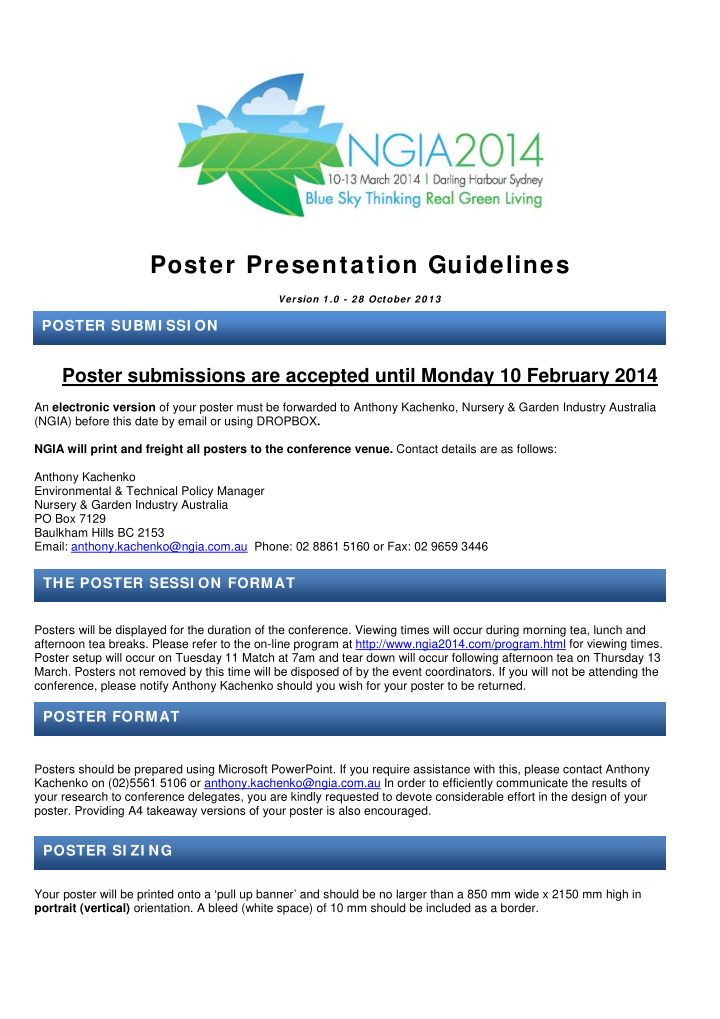



Poster Presentation Guidelines Version 1 .0 - 28 October 20 13 POSTER SUBMI SSI ON Poster submissions are accepted until Monday 10 February 2014 An electronic version of your poster must be forwarded to Anthony Kachenko, Nursery & Garden Industry Australia (NGIA) before this date by email or using DROPBOX . NGIA will print and freight all posters to the conference venue. Contact details are as follows: Anthony Kachenko Environmental & Technical Policy Manager Nursery & Garden Industry Australia PO Box 7129 Baulkham Hills BC 2153 Email: anthony.kachenko@ngia.com.au Phone: 02 8861 5160 or Fax: 02 9659 3446 THE POSTER SESSI ON FORMAT Posters will be displayed for the duration of the conference. Viewing times will occur during morning tea, lunch and afternoon tea breaks. Please refer to the on-line program at http://www.ngia2014.com/program.html for viewing times. Poster setup will occur on Tuesday 11 Match at 7am and tear down will occur following afternoon tea on Thursday 13 March. Posters not removed by this time will be disposed of by the event coordinators. If you will not be attending the conference, please notify Anthony Kachenko should you wish for your poster to be returned. POSTER FORMAT Posters should be prepared using Microsoft PowerPoint. If you require assistance with this, please contact Anthony Kachenko on (02)5561 5106 or anthony.kachenko@ngia.com.au In order to efficiently communicate the results of your research to conference delegates, you are kindly requested to devote considerable effort in the design of your poster. Providing A4 takeaway versions of your poster is also encouraged. POSTER SI ZI NG Your poster will be printed onto a ‘pull up banner’ and should be no larger than a 850 mm wide x 2150 mm high in portrait (vertical) orientation. A bleed (white space) of 10 mm should be included as a border.
FORMATTI NG GUI DELI NES/ SUGGESTI ONS Title • Place the title at the top centre of the poster. Use a minimum of 72 point letters. • Please include on your poster all contact details including name(s), organisation name, job title and email address(es). You may want to add your mobile phone number and provide some business cards to leave at your poster. • Do not use all capital letters in the title. Introduction • Size 35 point letters or above should be used as the text for the main body of the poster. • The introduction should contain 3 to 5 sentences outlining essential information necessary to understand the study and why it was done. Objectives/purpose/aim • The objectives/purpose/aim of the study should be clearly stated in as few words as possible. Methods • Outline your methods briefly – less is more. Discussion/conclusion • The discussion (if necessary) and conclusions should be succinctly stated on large type. Many viewers read this first and hence it should be easy to understand. General comments • Avoid hand drawn materials. • Keep it simple. Posters should be brief and concise with text kept to a minimum. • Make sure it has a logical flow. • Use colour, graphics, charts, and photos. Use high resolution photographs (web images often will not work). • Emphasize graphics, and make sure every item included in your poster is necessary. • Key points should be in large type. • Do not try to tell the entire story on the panel. • Be consistent – margins, shading and line spacing should be consistent and keep the colour, style, and thickness of borders the same. Pick no more than 2–3 fonts and colours and test readability. An example poster follows.
Recommend
More recommend